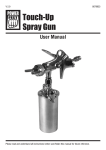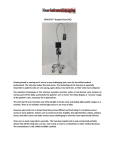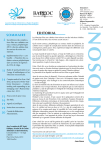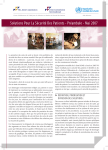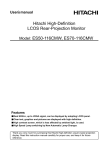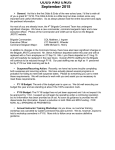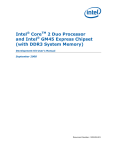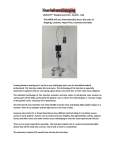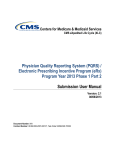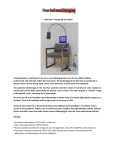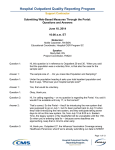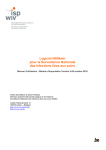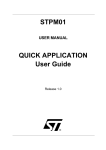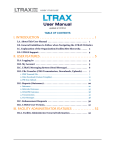Download Q&A Transcript - Quality Reporting Center
Transcript
Hospital Inpatient Quality Reporting Program Support Contractor FY 2016 IQR Hospital IPPS Final Rule Questions & Answers Moderator: Candace Jackson, RN Inpatient Quality Reporting (IQR) Program Lead, Hospital Inpatient Value, Incentives, and Quality Reporting (VIQR) Outreach and Education Support Contractor (SC) Speaker(s): Cindy Tourison, MSHI Program Lead of Hospital IQR Alignment and Hospital Value-Based Purchasing (VBP) Centers for Medicare & Medicaid Services (CMS) Grace Im, JD, MPH Program Lead of Hospital Readmissions Reduction Program (HRRP), CMS Delia L. Houseal, PhD, MPH Program Lead, Hospital-Acquired Condition (HAC) Reduction Program, CMS Charles Padgett, RN Health Insurance Specialist, Office of Clinical Standards and Quality Division of Chronic and Post-Acute Care, CMS September 2, 2015 2 p.m. ET Question 1: Is there a QualityNet report which shows 2015 hospital CURRENT standard population performance on NHSN measures? Right now all I can find are 2015 reports for COMBINED/new standard population data for CLABSI and CAUTI. Answer 1: The Facility, State and National report can be run to show the current performance of the NHSN measures. Question 2: When you refer to FY 2018, could you please specify which calendar dates this corresponds to? Answer 2: For the Hospital Inpatient Quality Reporting (IQR) Program, FY 2018 would correspond to calendar year 2016 (discharges from 01/01/2016 through 12/31/2016) for most measures. The outcomes measures vary. CMS intends to Page 1 of 23 Inpatient Quality Reporting Program Support Contractor publish a document on QualityNet in the next month that depicts the measurement period by measure by program. Question 3: I am interested in the Pneumonia measure removed, as we are starting a statewide project to improve pneumonia immunization. Answer 3: IMM-1, the Pneumococcal Vaccination Measure, was no longer compliant with current clinical guidelines. It was not feasible to implement the measure specifications that incorporated the new guidelines given their complexity. CMS believes that the measure, as updated by the guidelines, would burden hospitals with data abstraction and yield results with only questionable meaningfulness and reliability. Question 4: We have not been collecting IMM-1 or SCIP-4 this year? Were we supposed to collect this in CY 2015? Answer 4: For 01/01/2015 and forward discharges, IMM-1 is a voluntary measure that is not required to be submitted to CMS for the Inpatient Quality Reporting Program. SCIP-Inf-4 is a suspended measure that also is not required to be submitted to CMS. Question 5: What is the final discharge date on which the removed measures need to be collected? Answer 5: For the IQR Program, the last quarter to submit the removed measures will be with 4Q15 discharges. Question 6: When will slide 10 removal of measures go into effect? What if you are not fully electronic yet? Answer 6: The measures listed on slide 10 will no longer be required for the IQR program beginning with 01/01/2016 discharges. Question 7: Did I hear correctly – VTE-1 and -2 are going away? Answer 7: Both VTE-1 and VTE-2 are topped out measures that will be removed from the IQR program beginning with 01/01/2016 discharges. Question 8: I recently found our vendor is reporting on patient populations that should be excluded. I took this to the vendor and got the following reply. I am concerned with the submission of data that may be rejected or may reflect our facility negatively: "The problem with measure NQF 441 is that the CMS guidelines do not always follow their own logic. Translated this means that the “story” they give you at the top to describe this measure does not always match the logic of the measure. Depending on the Snomed code sets and logic placed into the “population criteria” section, some things will fall through the cracks." If this is Page 2 of 23 Inpatient Quality Reporting Program Support Contractor not corrected, and patient populations which should be excluded are reported on, how will this affect our facility? Answer 8: Cases that are excluded from the measure denominator (those that result in a Measure Outcome of “B”) are still part of the measure set initial patient population and are eligible to be abstracted and submitted to the CMS Clinical Warehouse. Question 9: Will the topped out measures for STK and VTE be removed or will we be able to voluntarily submit? Answer 9: The topped out measures for STK and VTE will be removed from the IQR program beginning with 01/01/2016 discharges. They will not be voluntary measures and you will not be able to submit them to the CMS Clinical Warehouse. Question 10: Are the chart abstracted versions of a measure required if the eCQM version of that same measure is submitted for the required eCQMs? Answer 10: There are eight chart-abstracted measures that are required to be submitted for a full year, regardless of which measures a facility chooses to submit to meet the four required eCQMs. Question 11: We are wondering about the likelihood of removing the eCQMs for the 2017 electronic reporting requirement and the implications for selecting any of these as part of the four required for 2016. Answer 11: There will not be any implications to submitting one of the eCQMs that were flagged as a possibility for removal in CY 2017. Please discuss with your vendor before deciding which eCQMs will be submitted. CMS has heard from several vendors that they will not continue support for those eCQMs that CMS signaled for removal. Question 12: Do we have to report the topped out measures electronically? Answer 12: No, you do not have to report the topped out measures electronically. However, you could choose one or more of the topped out measures’ electronic version of the measure to be submitted as part of the four required eCQMs. Question 13: Regarding slide 11: What is the abstracted time frame for FY 2018 payment determination? Answer 13: FY 2018 payment determination will include CY 2016 discharges (January 1 through December 31, 2016). Question 14: The speaker keeps saying FY16 when the slide says FY18. Can you clarify slide 14? Page 3 of 23 Inpatient Quality Reporting Program Support Contractor Answer 14: The new measures will be collected for FY 2018 payment determination, which will be for calendar year 2016 discharges. Question 15: How will the Patient Safety Culture data be reported? Answer 15: The Patient Safety Culture measure is a structural measure that will be reported through a web-based tool that is located on the QualityNet Secure Portal. Question 16: Will the structural measure re: Patient Safety Culture Survey identify what defines a standardized tool? For example, if a hospital uses a hybrid of the AHRQ and another tool, is that considered standardized? Answer 16: In the IPPS Final Rule, CMS does not define what is considered a “standardized” tool. The Patient Safety Culture Survey asks “Does your facility administer a detailed assessment of patient safety culture using a standardized collection protocol and structured instrument?” If you feel that your hybrid tool meets these criteria, then you would be able to answer “Yes” to the measures. Question 17: For slides14 and 15, you say for FY 2018 and FY 2019 Payment determination – What are the data collection periods for these two years? Answer 17: In the IQR Program for FY 2018, the data collection is 01/01/2016 and forward; for FY 2019 the data collection is 01/01/2017 and forward. Question 18: Does payment year 2018 mean that data will be collected in 2016 for 2018 payment? Answer 18: The FY 2018 Hospital Quality Reporting (HQR) Programs have varying performance periods based on the measures. CMS intends to publish a document on QualityNet in the next month that depicts the measurement period by measure by program. Question 19: Will the Sepsis measure be included in validation? Answer 19: Yes, the Sepsis measure will be included in validation. Question 20: What is the HTN measure? Answer 20: Healthy Term Newborn. Question 21: Will the four eCQM measures also meet MU – EH reporting requirements? Answer 21: Yes, submission of data for four eCQMs will meet the Clinical Quality Measure reporting requirement for the EHR Incentive Program (MU). Question 22: How will CMS know which measures we will be submitting the eCQM for and which we are still abstracting manually and sending to CMS quarterly? Page 4 of 23 Inpatient Quality Reporting Program Support Contractor Answer 22: Hospitals must submit eight chart-abstracted measures that are required to be submitted for a full year and choose four required eCQMs to submit. Question 23: By eCQMs, do you mean Meaningful Use Measures or e-Measures? Answer 23: The term e-Measures is synonymous with eCQMs. The IQR Program and the EHR Incentive Program (MU) have alignment across the eCQMs. A facility will need to submit data for four of the available eCQMs to meet the IQR Program requirement, and this submission will also meet the EHR Incentive Program’s Clinical Quality Measure submission requirement. Question 24: What specification manual is used for those eCQM measures that have been retired from chart-abstracted measures? Answer 24: The eCQM specifications can be found on the CMS eCQM Library page of the CMS website. The link to the page is https://www.cms.gov/regulations-andguidance/legislation/ehrincentiveprograms/ecqm_library.html. Scroll down the page to find the April 2014 Update for eReporting for the 2015 Reporting Year for Eligible Hospital measures. Question 25: When selecting eCQMs for the FY 17 payment determination, do hospitals select by indicator or by measure set, i.e., can SCIP-Inf-1a be selected, without selecting SCIP-Inf-2a and SCIP-Inf 9? Answer 25: A facility can select any four of the available eCQMs. Measure sets are not required. Question 26: If Fourth Quarter eCQM is chosen, is manual abstraction required for first, second, and third quarters? Answer 26: Manual abstraction of the eight chart-abstracted measures is required for the full year. Question 27: I need to know more about the Zero Denominator Exclusion. We have a 21 bed state-run acute care hospital on the campus of a state-run psych hospital. We would have zero cases most quarters that would fit the eCQMs. Answer 27: Zero Denominator Declarations are accepted for eCQM data submission. CMS encourages the selection of eCQMs that best represent a facility’s patient population. However, if the four measures most relevant have a zero denominator, that would fulfill the eCQM requirement. Question 28: What year will the chart-abstracted measures from slide 10 be retired (i.e., no longer actually abstract the records)? Answer 28: This has not been determined as of yet by CMS. The removal of the measures will be proposed in the 2017 IPPS rule. Page 5 of 23 Inpatient Quality Reporting Program Support Contractor Question 29: Do you know if The Joint Commission will continue or retire any of the retired abstracted measures in alignment with CMS or when they will make their decision? Answer 29: We are unable to provide a response to your question. Please refer your question to The Joint Commission. Question 30: Does this mean you can no longer manually attest eCQM for EHR Incentive/MU? Answer 30: Critical Access Hospitals are able to attest Clinical Quality Measure data to meet the Clinical Quality Measure requirement for the EHR Incentive Program utilizing the CMS Registration and Attestation system. All other eligible hospitals are required to select 4 eCQMs and submit QRDA files for CY 2016 3rd or 4th by the submission deadline February 28, 2017 to satisfy the eCQM requirement for both IQR and the EHR Incentive programs. Question 31: Is IMM-2 removed or moved in VBP? Answer 31: The IMM-2 measure was removed from the Hospital VBP Program in FY 2018. The IMM-2 measure was included in the Clinical Process of Care/Clinical CareProcess Domain in FY 2016 and FY 2017. Question 32: Can you provide a link to the 2016 Implementation guide for QRDA-I? Answer 32: The 2016 QRDA Implementation Guide can be found on the eCQM Library Page of the CMS website. The link is https://www.cms.gov/regulations-andguidance/legislation/ehrincentiveprograms/ecqm_library.html. Scroll down to the bottom of the page to find the guide listed under QRDA Resources. Question 33: What month does data collection stop for the measures removed for the Hospital IQR Program (STK-01, -06, -08, VTE-1, -2, -3, IMM-1, AMI-7a, and SCIP-Inf4)? Answer 33: The last quarter to collect and submit these measures is the fourth quarter of 2015 discharges. Question 34: Why must we submit PC-01 as a web-based measure if our core measure vendor submits all Perinatal Care measures to TJC? Answer 34: There is no contract between CMS and The Joint Commission to exchange data. As such, all data that are used by CMS must be submitted to CMS through the QualityNet Secure Portal. Question 35: Is there an eCQM specification for CTM-3 NQF #0228? Answer 35: The eCQM specifications can be found on the CMS eCQM Library page of the CMS website. The link to the page is here: https://www.cms.gov/regulations-andPage 6 of 23 Inpatient Quality Reporting Program Support Contractor guidance/legislation/ehrincentiveprograms/ecqm_library.html. Scroll down the page to find the April 2014 Update for eReporting for the 2015 Reporting Year for Eligible Hospital measures. Question 36: Is the expanded cohort for Pneumonia Readmission and Mortality effective FY 2017, not FY 2016? Answer 36: These updated measures will be used beginning with the FY 2017 payment determination for the Hospital Inpatient Quality Reporting (IQR) Program. The updated pneumonia readmission measure will be used beginning with the FY 2017 payment adjustment determination for the Hospital Readmissions Reduction Program. The expanded cohort for the Pneumonia 30-Day Mortality Measure has not been proposed for the Hospital VBP Program. Question 37: What is the ninth HCAHPS® indicator? Answer 37: The ninth HCAHPS® dimension that was adopted for the FY 2018 Hospital VBP Program was the Care Transition Measure (CTM-3). Question 38: Can hospitals access CY 15 CURRENT standard population (ICU-only) performance on NHSN measures through QNET feedback reports? Answer 38: Beginning with 01/01/2015 hospitals must submit CAUTI and CLABSI data for all wards. As such, ICU is not independently reported out. On the feedback reports it will only display the combined data. Question 39: Are we understanding correctly that PC-01 will not be validated in the new validation process? Answer 39: As only aggregate data is submitted for the PC-01 measure, the PC-01 measure is not validated. Question 40: How does new CTM-3 relate/be similar to HCAHPS®? Answer 40: The CTM–3 measure adds three questions to the HCAHPS® Survey, as follows: • • • During this hospital stay, staff took my preferences and those of my family or caregiver into account in deciding what my health care needs would be when I left. When I left the hospital, I had a good understanding of the things I was responsible for in managing my health. When I left the hospital, I clearly understood the purpose for taking each of my medications. Question 41: CY 2015/FY 2017: If hospitals don’t submit STK-02, -03, -04, -06, -05, -08 as eCQM, they still have to chart-abstract/submit STK-1. Is it right? Page 7 of 23 Inpatient Quality Reporting Program Support Contractor Answer 41: Yes, if a hospital selects not to submit these as eCQMs, then STK-1 is required. Question 42: What will the measures (the four measures that are chosen for eCQM) look like on Hospital Compare? For example, will there be an N/A, a blank space, or totally removed from Hospital Compare? Answer 42: For CY 2016/FY 2018 eCQM data submission, data will not be listed on Hospital Compare initially. CMS signaled to make a proposal in the next IPPS rule on its public reporting of eCQM data. Question 43: Will we be required to submit the four eCQM measures using the QRDA 1 format? Answer 43: QRDA-Category I will be required for eCQM data submission. Question 44: Will the VBP program continue to use critical care data only for CAUTI and CLABSI for the CY 2015 and CY 2016 reporting years? Answer 44: The Hospital VBP Program will use the ICU only locations (Adult, Pediatric, and Neonatal for CLABSI) and (Adult and Pediatric for CAUTI) for the FY 2016, FY 2017, and FY 2018 Hospital VBP Programs. The transition to the expanded locations will occur in the FY 2019 Hospital VBP Program, because the baseline period (CY 2015) will contain the expanded locations for the first time, and consistency is needed to accurately compare the baseline and performance periods for purposes of improvement points. Question 45: Our hospital is a new hospital opening in 2013 July. Does this mean we will have no comparison data for CAUTI, CLABSI, CDI, and MRSA? Answer 45: The FY 2018 Hospital VBP Program utilizes varying baseline periods that are dependent upon the measure or measure type. A hospital opening in the middle of or after the baseline period may not have sufficient data to have improvement points calculated; however, hospitals with sufficient data during the performance period still have an opportunity to earn achievement points. Question 46: How will the VTE-1 through -3 retirement affect the sub-population sampling? Will sub-population one and two go away or just sub-population one? Answer 46: This is currently under review. Changes to the VTE sub-populations will be published in an addendum to the Specifications Manual, Version 5.0a. The addendum, Version 5.0b, is expected to be published mid-October. Question 47: Can you share the PowerPoint slides in addition to the PDF? Answer 47: Thank you for your question; we are unable to provide the slides in PowerPoint. Page 8 of 23 Inpatient Quality Reporting Program Support Contractor Question 48: What will be CMS' data source for the new measure, Hospital Survey on Patient Safety Culture? Answer 48: The Hospital Survey on Patient Safety Culture will be a Structural Measure that will be collected through a web-based application through the Secure Portal. The Structural Measure will ask, “Does your facility administer a detailed assessment of patient safety culture using a standardized collection protocol and structured instrument?” Question 49: It was mentioned that some eCQMs could be removed in CY 2017. When would we be required to report eCQMs in 2017? Answer 49: eCQM reporting requirements for CY 2017/FY 2019 will be outlined in the CY 2017/FY 2019 Final Rule. Question 50: If PC-01 is submitted electronically for the IQR program, is that submission used for the PC-01 requirement for VBP? And how will these be handled on the Hospital Compare website for this measure? Answer 50: Currently the Hospital VBP Program only utilizes data from the chart-abstracted form of the PC-01 measure. Question 51: Are CAHs still exempt from HAC Reduction Program? Answer 51: Yes, Critical Access Hospitals are still exempt from the HAC Reduction Program. Question 52: For COPD Mortality for proposed FY 2021, what will be the performance period? Answer 52: The 30-Day Mortality Measure for COPD will utilize a baseline period of July 1, 2011 through June 30, 2014 and a performance period of July 1, 2016, through June 30, 2019. For the FY 2021 Hospital VBP Program, the baseline and performance period ranges for the COPD measure are consistent with the other 30-Day Mortality Measures included in the Hospital VBP Program. Question 53: Where would we find the ICD-10 codes for RRP? Answer 53: CMS has specified the AMI, HF, pneumonia, and COPD measure cohorts by creating preliminary lists of ICD-10 codes that define AMI, HF, pneumonia, and COPD admissions for inclusion in the quality reporting and payment programs that use these outcome measures. The National Quality Forum (NQF) requires ICD-10 code lists in the measure submission process. CMS has made these lists available in the CMS/Joint Commission Specifications Manual for National Hospital Inpatient Quality Measures (Version 4.4a), posted on QualityNet at: http://www.qualitynet.org > Hospitals – Inpatient > Specifications Manual > Version 4.4a > Appendix P. The ICD-10 codes for the AMI, HF, pneumonia, and COPD are in Tables 14.1, 14.2, 14.3, and 14.4, respectively. It is important to note that these lists cannot be considered final until they can be verified by Page 9 of 23 Inpatient Quality Reporting Program Support Contractor directly examining the frequency and consistency with which hospitals actually use the ICD-10 codes in claims they submit to CMS. CMS has specified the total hip/total knee arthroplasty (THA/TKA) readmission measure cohort by creating preliminary lists of ICD-10 codes that define an elective primary THA/TKA procedure. These codes are available on the NQF website. To access these lists: 1) 2) 3) 4) 5) Go to http://www.qualityforum.org/QPS/1551 Click on the “VIEW THE NEW SPEC …” bar Unzip the MIFForm_1551.zip file Expand the 1551 folder Open up the NQF_1551_S2b_Data_Dictionary_6.20.14.xlsx file It is important to note that these lists cannot be considered final until they can be verified by directly examining the frequency and consistency with which hospitals’ actually use the ICD-10 codes in claims they submit to CMS. For more information regarding readmission measures, please feel free to contact [email protected]. Question 54: What is the performance period for HRRP FY 2017 that will include the increased PN population? Answer 54: For the FY 2017 Hospital Readmissions Reduction Program, CMS will be using eligible hospital discharges that occurred between July 1, 2012 and June 30, 2015. Question 55: Could you please clarify FY vs. CY? I thought that FY 2018 is calendar year 2016, but this speaker (Grace Im) is referring to FY 2016 beginning in October 2015. Answer 55: For the HRRP Program, FY 2016 refers to payment adjustments that will apply to discharges beginning October 1, 2015 through September 30, 2016 for excess readmissions that were calculated based on a performance period of July 1, 2011– June 30, 2014. CY refers to Calendar Year (January 1–December 31) of the same year. Please see Question #2 for the Hospital IQR Program. Question 56: For pneumonia readmission, some of the early information was going to include not only inpatient readmit but ED visits and observations. Has this not been included in the Final Rule? Answer 56: CMS finalized in the FY 2016 IPPS/LTCH PPS Final Rule an expansion of the current pneumonia cohort to include patients with a principal discharge diagnosis of pneumonia or aspiration pneumonia, and patients with a principal discharge diagnosis of sepsis with a secondary diagnosis of pneumonia coded as present on admission (POA), but does not include patients with a principal discharge diagnosis of respiratory failure or patients with a principal discharge diagnosis of Page 10 of 23 Inpatient Quality Reporting Program Support Contractor sepsis if they are coded as having severe sepsis. The readmission measures do not take into account emergency department visits or observation stays. Please note that in the FY 2016 IPPS/LTCH PPS Final Rule, CMS did finalize the Excess Days in Acute Care (EDAC) after Hospitalization for Heart Failure measure and the Excess Days in Acute Care (EDAC) after Hospitalization for Acute Myocardial Infarction measure beginning with the FY 2018 payment determination year in the Hospital IQR Program. These are separate measures that specifically take into account emergency department visits or observation stays. Question 57: Can you please recap the Pneumonia Readmission measure (and Mortality) cohort? So, patients with respiratory failure or coded as having severe sepsis is not finalized yet? If not, what is the timeline for this to be final or rejected? Answer 57: In the FY 2016 IPPS/LTCH PPS Final Rule, CMS finalized a modified version of the expanded pneumonia cohort; the modified version of the expanded pneumonia cohort includes patients with a principal discharge diagnosis of pneumonia or aspiration pneumonia, and patients with a principal discharge diagnosis of sepsis with a secondary diagnosis of pneumonia coded as POA, but does not include patients with a principal discharge diagnosis of respiratory failure or patients with a principal discharge diagnosis of sepsis if they are coded as having severe sepsis. Question 58: Will hospitals continue to be held accountable for "all cause readmissions?" Answer 58: The Hospital-Wide All-Cause Unplanned Readmission Measure will continue to be collected by the IQR program for FY 2018 and subsequent years. Question 59: What are the percentage penalties for VBP, RR, HAC for FY18? Answer 59: The Hospital VBP Program has a withhold percentage of 2.0%. Hospitals may earn back a value-based incentive that allows the hospital to earn back a portion of their withhold percentage or even surpass the withhold percentage and receive an increase in payments due to the Hospital VBP Program. HAC Reduction Program: effective 2015, the law required the Secretary of the Department of Health and Human Services to reduce payments to hospitals that rank in the quartile of hospitals with the highest Total HAC Scores (i.e., the worst-performing 25 percent) by one percent. Hospital Readmission Reduction Program: the payment adjustment factor for each hospital is either the greater of the Ratio or, a floor adjustment factor of 0.97 (i.e., 3% reduction). In other words, for FY 2015 and subsequent fiscal years, a hospital subject to the Hospital Readmissions Reduction Program will have an adjustment factor that is between 1.0 (no reduction) and 0.9700 (greatest possible reduction). Question 60: What is the performance period for HRRP (readmissions) for FY 2017? Page 11 of 23 Inpatient Quality Reporting Program Support Contractor Answer 60: For the FY 2017 Hospital Readmissions Reduction Program, CMS will be using eligible hospital discharges that occurred between July 1, 2012 and June 30, 2015 to calculate the excess readmission ratios. Question 61: Participation in EHR Incentive/MU Program but not IQR: will it be mandatory for CAH to report four eCQMs for 3Q16 or 4Q16 by 2/28/17? Answer 61: CAHs will have two options to meet the Clinical Quality Measure requirements. One option is to submit data for four of the available eCQMs utilizing the QualityNet Secure Portal. Another option is to submit aggregate data for 16 of the 29 available eCQMs utilizing the CMS Registration and Attestation System. Question 62: Regarding slide #45. We recently received a "dry run" report for the PSI-11 measure, which seemed to indicate that it will be publically reported. Does this mean that PSI-11 will be incorporated into the PSI-90 composite? If so when will we know? Answer 62: The AHRQ PSI–90 Composite measure was under NQF maintenance review at the time of FY 2016 IPPS/LTCH PPS Final Rule. Therefore, no changes were finalized to add the PSI-11 measure (Postoperative Respiratory Failure) as a component to the PSI-90 Composite measure. In August 2015, CMS publically reported the PSI-11 measure (Postoperative Respiratory Failure) on Data.CMS.gov, along with four measures from the Deficit Reduction Act (DRA) HAC Present on Admission (POA) program (Foreign Object Retained After Surgery, Blood Incompatibility, Air Embolism, and Falls and Trauma) to identify complications and undesirable situations or conditions that patients experience in hospital. Improving patient safety is one of the ultimate goals of quality improvement, and publicly reporting on the DRA HAC and PSI measures remain an important aspect of CMS’ commitment to patient safety. Question 63: When will the AHRQ version 5.0 be applied to the PSI measures in the HACRP? Answer 63: CMS has not yet determined which version to use for future years of the Hospital Quality Reporting Programs (HAC, IQR, or HVBP). The decision on which software version to use also depends on timelines and input from the National Quality Forum’s Measure Application Partnership. The QualityNet Claims-Based Measures Resources web page includes a table labeled “Basic Summary of AHRQ Methods and Software in Each Program.” This shows the current software version being used for each program that utilizes the AHRQ PSIs and the pertinent performance periods for each. It also includes links to the PSI technical specifications. Additional information is available on the AHRQ PSI website. Question 64: If ED-1, -2, IMM-2, STK-04, VTE-5, and -6 require to chart-abstract for FY 2018, the total available eCQMs will not be 28. It will be 23 eCQMs (28-5)? Page 12 of 23 Inpatient Quality Reporting Program Support Contractor Answer 64: There are eight chart-abstracted measures that are required to be submitted for a full year, even if a facility chooses to submit any of those as the four required eCQMs. The eight required chart-abstracted measures are ED-1, ED-2, Imm-2, STK-4, VTE-5, VTE-6 and PC-01. Question 65: When the FY 2016 HAC preview report will be released? Answer 65: Hospital-specific report (HSR) previews are delivered to Inpatient Quality Reporting (IQR) participating hospitals during the April/May timeframe each year. HAC Reduction Program participating hospitals have the opportunity to preview results using these HSRs, as well. HAC Reduction Program participating hospitals also receive separate HSRs specific to the HAC Reduction Program measure results and scoring methodology. Question 66: Will the HAC program use critical care only data from CALBSI and CAUTI for scoring hospitals into deciles in FY 17? Answer 66: Measure Refinements for the FY 2018 HAC Reduction Program include Select Ward (Non-Intensive Care Unit [ICU]) Locations in Certain CDC NHSN Measures beginning in the FY 2018 Program Year. CMS will include data from pediatric and adult medical ward, surgical ward, and medical/surgical ward locations, in addition to data from adult and pediatric ICU locations for the Centers for Disease Control Prevention (CDC) National Health Safety Network (NHSN) Central Line-Associated Bloodstream Infections (CLABSI) and Catheter-Associated Urinary Tract Infections (CAUTI) measures beginning with the FY 2018 HAC Reduction Program Question 67: Is the HAC POA Program going away, or is there an update on it? Answer 67: We do not have information about closure of the Deficit Reduction Act (DRA) Hospital-Acquired Condition (HAC) Present on Admission (POA) program at this time. Question 68: Can you tell us if new specifications with ICD-10 codes have been released? If not, when do you anticipate releasing these measures? Answer 68: The ICD-10 specifications for the chart-abstracted measures, for the IQR Program, have been released and are available in the Specifications Manual, Version 5.0a, that is posted on QualityNet. Please also see Question #53 for more information. Question 69: We are a LTC facility located within a public hospital district. We have 50 beds, and our sister ACH, located within the same district, is a CAH. We currently report MDS data, but I am unfamiliar with the CARE Data Set nomenclature. Are these data sets and measures one and the same? Page 13 of 23 Inpatient Quality Reporting Program Support Contractor Answer 69: The LTCH QRP Final Rule presentation is relevant to all Long-Term Acute Care Hospitals (LTCHs), as opposed to Long-Term Care facilities, such as nursing homes (NHs) and skilled nursing facilities (SNFs). NHs and SNFs use the MDS 3.0. Long-term care hospitals (LTCHs) and long-term acute care hospitals are different names for the same type of hospital. Medicare uses the term long-term care hospitals. These hospitals are certified as acute care hospitals that treat patients requiring extended hospital-level care, typically following initial treatment at a general acute care hospital. If a hospital is classified as an LTCH for purposes of Medicare payments (as denoted by the last four digits of its six digit CMS Certification Number [CCN] in the range of 2000–2299), it is subject to the requirements of the LTCH Quality Reporting Program. If your critical access hospital (CAH) has long-term care beds that either provide skilled nursing facility-level or nursing facility-level care, it is not required to comply with a requirement that was mandated for LTCHs, which are hospitals. Question 70: For the LTCH All-Cause Unplanned Readmission Measure – is that readmission to an acute care facility? Answer 70: The quality measure All-Cause Unplanned Readmission Measure for 30 Days Post-Discharge from Long-Term Care Hospitals looks at readmissions to acute care level services during the 30 days following discharge from the LTCH, which include readmissions to LTCHs, as well as Acute-Care Hospitals. Question 71: NHSN CLABSI and CAUTI Measures – Is this measure only the SIRs or does it include all the incidence and prevalence measures associated with these CDC measures? Answer 71: Please submit your question to the Inpatient Q&A tool so we can respond to your question from the applicable program. Question 72: Is there any plan to move the AHRQ PSI-90 baseline forward to a more current time period? Answer 72: The AHRQ PSI-90 Composite baseline periods have been announced and finalized up to FY 2020. You may reference the IPPS Final Rule to view the most recent data periods for the Hospital VBP Program. Question 73: Where can we find the hardship policy and application for the four IQR eCQM reporting requirement? Answer 73: Hospitals can use the Extraordinary Circumstance Extensions/Exemptions Request Form that is located on QualityNet at https://www.qualitynet.org/dcs/ContentServer?c=Page&pagename=QnetPublic% 2FPage%2FQnetTier3&cid=1228762258913. Question 74: Would the table for pneumonia in the Version 8.0 of Condition Specific Measures Updates and Specification Report Hospital-Level 30-Day Risk Standardized Page 14 of 23 Inpatient Quality Reporting Program Support Contractor Readmission Measures be used to determine what population will be looked at for pneumonia readmissions within 30 days? Answer 74: Yes, the 2015 Condition-Specific Measures Updates and Specifications Report Hospital-Level 30-Day Risk-Standardized Readmission Measures document describes the CMS condition-specific readmission measures used in the Hospital Inpatient Quality Reporting (IQR) program. CMS also uses these AMI, HF, pneumonia, and Chronic Obstructive Pulmonary Disease (COPD) readmission measures in the Hospital Readmissions Reduction Program. The Hospital Readmissions Reduction Program includes only subsection (d) hospitals and hospitals located in Maryland. Because the set of hospitals for which these measures are calculated for the Hospital Readmissions Reduction Program differs from those used in calculations for the IQR program, hospital scores may differ. Question 75: Why does the LTCH care data set guidelines version 3.0 as shown on page 58 of the slides not include the functional assessment measure? Answer 75: The functional Assessment Measures are included in the LTCH CARE Data Set version 3.0. These measures were accidentally omitted from the slide. Thank you for pointing out this important point. Question 76: How do we know we qualify for reporting LTCH? Answer 76: Long-term care hospitals (LTCHs) and long-term acute care hospitals are different names for the same type of hospital. Medicare uses the term long-term care hospitals. These hospitals are certified as acute care hospitals that treat patients requiring extended hospital-level care, typically following initial treatment at a general acute care hospital. If a hospital is classified as an LTCH for purposes of Medicare payments (as denoted by the last four digits of its six digit CMS Certification Number [CCN] in the range of 2000–2299), it is subject to the requirements of the LTCH Quality Reporting Program. If your critical access hospital (CAH) has long-term care beds that either provide skilled nursing facility-level or nursing facility-level care, it is not required to comply with a requirement that was mandated for LTCHs, which are hospitals. Question 77: Is there a table available that lists out the VBP measures that are valid for 2016 and the domains the measures belong to? Answer 77: The IPPS Final Rule lists the measures for the FY 2018 Hospital VBP Program in table form. We have plans to release an infographic with the FY 2018 measures, domains, domain weights, performance standards, and data periods in the future. Question 78: Is the measure PCCEC/CC chart-abstracted or part of the HCAHPS® survey? What does PCCEC/CC stand for; and is it part of the HCAHPS® dimensions? Page 15 of 23 Inpatient Quality Reporting Program Support Contractor Answer 78: The Patient- and Caregiver-Centered Experience of Care/Care Coordination (PCCEC/CC) Domain includes the HCAHPS® dimensions and utilizes data that was collected through the HCAHPS® Survey. Question 79: Please explain what is meant on page 26, second bulleted note “CMS will require payment determination hospitals to submit eCQMs using the 2015 Annual Update?” Answer 79: eCQM specifications are updated annually. For 2016 eCQM data submission, the 2015 Annual Update of the eCQM specifications is required. Question 80: What is the LTCH QRP website URL? Answer 80: https://www.cms.gov/Medicare/Quality-Initiatives-Patient-AssessmentInstruments/LTCH-Quality-Reporting/index.html?redirect=/LTCH-QualityReporting/ Question 81: Regarding IRF –PAI, what does the PAI stand for? Answer 81: IRF-PAI stands for Inpatient Rehabilitation Facility (IRF) Patient Assessment Instrument (PAI). Question 82: For the IQR eCQM submission, can ED3 be submitted even though it is not an IQR measure? Answer 82: No, submission of data for the ED-3 measure would not meet IQR program requirements for eCQM as ED-3 is an Outpatient measure and not applicable to IQR. Question 83: The same for the IRF – how do we know that we have to submit the data? Answer 83: If your IRF is paid under the CMS IRF PPS system, then you are subject to the requirements of the IRF Quality Reporting Program. For further information related to the CMS classification of IRFs, we refer you the IRF-PAI Training Manual. Information regarding classification and payment under the IRF PPS begins on page I-3 of this manual. You can access the manual at https://www.cms.gov/medicare/medicare-fee-for-servicepayment/inpatientrehabfacpps/downloads/irfpai-manual-2012.pdf. Question 84: Do you have another webinar for eCQM reporting Options? Where we can get the detailed information (Submission Options for eCQM Reporting CY 2016/FY 2018) Answer 84: There will be education on the eCQM reporting program requirements in CY 2016. Page 16 of 23 Inpatient Quality Reporting Program Support Contractor Question 85: Has CMS considered delaying reporting on Severe Sepsis and Septic Shock until discharges starting 1/1/2016? Answer85: There is no delay in the collection and reporting of the Sepsis measure. Collection of this measure begins with 10/01/2015 discharges. Question 86: HRRP: Please clarify when the planned readmission algorithm will be/was in effect and reflected on hospital penalties. Answer 86: CMS began using a new planned readmission algorithm in FY 2014. This would have been reflected on hospital readmissions beginning October 1, 2013. For FY 2016, CMS identifies planned readmissions using version 3.0 of its Planned Readmission Algorithm. The use of version 3.0 of the Planned Readmission Algorithm is aligned with the Hospital Inpatient Quality Reporting program for FY 2016 reporting. Details about the Planned Readmission Algorithm version 3.0 can be found in the 2015 Measure Updates and Specifications Reports, which are posted on QualityNet at: (www.qualitynet.org) > Hospitals-Inpatient > Claims-Based Measures > Readmission Measures > Measure Methodology. Question 87: How do we know if our Rehab unit is required to submit the information? Answer 87: If your Rehab unit is paid under the CMS IRF PPS system, then you are subject to the requirements of the IRF Quality Reporting Program. For further information related to the CMS classification of IRFs, we refer you the IRF-PAI Training Manual. Information regarding classification and payment under the IRF PPS begins on page I-3 of this manual. You can access the manual at https://www.cms.gov/medicare/medicare-fee-for-servicepayment/inpatientrehabfacpps/downloads/irfpai-manual-2012.pdf. Question 88: For IRF QRP, are there plans to make a facility, state and national report available similar to what's available for IQR, OQR? Answer 88: Yes, in the FY 2016 IRF PPS Final Rule, we finalized our policy related to the public reporting of IRF performance on quality metrics. IRFs will be given a chance to preview their performance data prior to the public posting of that data. Reports will include state and national rates, as well. For further information, you can access the FY 2016 IRF PPS Final Rule at http://www.gpo.gov/fdsys/pkg/FR2015-08-06/pdf/2015-18973.pdf. Question 89: For HRRP, are they just subtracting 2011–2012 and adding 2014–2015? Answer 89: For the FY 2017 Hospital Readmissions Reduction Program, CMS will be using eligible hospital discharges that occurred between July 1, 2012 and June 30, 2015 to calculate the excess readmission ratios. Page 17 of 23 Inpatient Quality Reporting Program Support Contractor CMS calculates the excess readmission ratios using a rolling three-year measurement timeframe. Each year, the excess readmission ratios are calculated, shifting the rolling three-year ratios by one year. Using this approach increases the number of cases per hospital used for measure calculation, which improves the precision of each hospital's readmission estimate. This method particularly helps small hospitals that would have had an insufficient number of cases for any given year. Using three years of data improves the accuracy of the excess readmission ratio calculation for which payment determinations are based and allows CMS to identify variation in hospital performance Question 90: The Proposed Rule mentioned that because of PAC, Home Cares and SNFs would have to submit the same measures under the LTCH program. Is this not the case? Answer 90: The CMS SNF Quality Reporting Program has its own set of requirements. The IMPACT Act of 2014 requires CMS to develop and implement cross-setting quality measures that span the post-acute care settings, including Skilled Nursing Facilities (SNFs), Home Health (HH), Inpatient Rehabilitation Facilities (IRFs), and Long-Term Care Hospitals (LTCHs). For more information on the SNF Quality Reporting program we invite you to visit the CMS SNF QRP webpage at https://www.cms.gov/Medicare/Quality-Initiatives-Patient-AssessmentInstruments/NursingHomeQualityInits/SNF-Quality-Reporting.html. Question 91: Have the readmit reduction specs been made available in ICD- 10? Answer 91: CMS has specified the AMI, HF, pneumonia, and COPD measure cohorts by creating preliminary lists of ICD-10 codes that define AMI, HF, pneumonia, and COPD admissions for inclusion in the quality reporting and payment programs that use these measures. The National Quality Forum (NQF) requires ICD-10 code lists in the measure submission process. CMS has made these lists available in the CMS/Joint Commission Specifications Manual for National Hospital Inpatient Quality Measures (Version 4.4a), posted on QualityNet at: http://www.qualitynet.org > Hospitals – Inpatient > Specifications Manual > Version 4.4a > Appendix P. The ICD-10 codes for the AMI, HF, pneumonia, and COPD are in Tables 14.1, 14.2, 14.3, and 14.4, respectively. It is important to note that these lists cannot be considered final until they can be verified by directly examining the frequency and consistency with which hospitals’ actually use the ICD-10 codes in claims they submit to CMS. CMS has specified the total hip/total knee arthroplasty (THA/TKA) readmission measure cohort by creating preliminary lists of ICD-10 codes that define an elective primary THA/TKA procedure. These codes are available on the NQF website. To access these lists: 1) 2) 3) 4) Go to http://www.qualityforum.org/QPS/1551 Click on the “VIEW THE NEW SPEC …” bar Unzip the MIFForm_1551.zip file Expand the 1551 folder Page 18 of 23 Inpatient Quality Reporting Program Support Contractor 5) Open up the NQF_1551_S2b_Data_Dictionary_6.20.14.xlsx file It is important to note that these lists cannot be considered final until they can be verified by directly examining the frequency and consistency with which hospitals’ actually use the ICD-10 codes in claims they submit to CMS. For more information regarding readmission measures, please feel free to contact [email protected]. Question 92: When will we get the HRRP payment adjustment amount for FY2015? Answer 92: Section 1886(q)(3)(A) of the Social Security Act defines the ‘‘adjustment factor’’ for an applicable hospital for a fiscal year as equal to the greater of (i) the ratio described in subparagraph (B) for the hospital for the applicable period (as defined in paragraph (5)(D)) for such fiscal year; or (ii) the floor adjustment factor specified in subparagraph (C). Section 1886(q)(3)(B) of the Social Security Act, in turn, describes the ratio used to calculate the adjustment factor. Specifically, it states that the ratio is equal to 1 minus the ratio of—(i) the aggregate payments for excess readmissions and (ii) the aggregate payments for all discharges. Section 1886(q)(3)(C) of the Social Security Act specifies the floor adjustment factor, which is set at 0.97 (i.e., 3% reduction) for FY 2015 and subsequent fiscal years. In other words, for FY 2015 and subsequent fiscal years, a hospital subject to the Hospital Readmissions Reduction Program will have an adjustment factor that is between 1.0 (no reduction) and 0.9700 (greatest possible reduction). The payment adjustment factors for all hospitals for FY 2016 were posted with the FY 2016 IPPS Final Rule and hospitals can download a supplemental data file to find the payment adjustment factor for their hospital. Go to https://www.cms.gov/Medicare/Medicare-Fee-for-ServicePayment/AcuteInpatientPPS/FY2016-IPPS-Final-Rule-Home-PageItems/FY2016-IPPS-Final-Rule-DataFiles.html?DLPage=1&DLEntries=10&DLSort=0&DLSortDir=ascending and scroll down the page to the downloads area. Click on the file labeled “FY 2016 IPPS Final Rule: Hospital Readmissions Reduction Program Supplemental Data File”. Within this zipped file you will find an excel workbook titled “FY 2016 IPPS Final Rule readmissions PUF revised 8-04-15.xlsx”. The second tab of this workbook, labeled “Final Rule FY 2016,” lists the payment adjustment factor for all hospitals by CCN number. To determine the percent that a hospital’s payment will be reduced, the adjustment factor is subtracted from 1.000 and multiplied by 100. Example: Hospital “A” has a readmission adjustment factor of 0.9750. To determine the percentage the hospital’s payment is reduced, subtract the readmission adjustment factor from 1.0000 and multiply by 100 (see below). 1.0000 - 0.9750 = 0.025 x 100 = 2.5% adjustment. Question 93: So just to clarify, CAHs do not have to do IQR but they do have to do the eCQM? Page 19 of 23 Inpatient Quality Reporting Program Support Contractor Answer 93: CAHs are not required to participate in the IQR program. If a CAH chooses to participate in the program, they would not need to meet the eCQM program requirement as part of the program requirements. Question 94: How often do you need to do the Culture of Safety? AHRQ says every two years. Is this measure the same? Answer 94: For CMS, the Patient Safety Culture Structural Measure will be collected once a year. Question 95: Will the hospital survey on Patient Safety Culture be answered in relation to whether a survey was done in 2015 or in 2016? Answer 95: The Patient Safety Culture Survey question will first be reported in 2016 which will reflect if it was used in 2015. Question 96: Will the removed measures (VTE-1, -2, -3, STK -1, etc.,) still be required for fourth quarter 2015? Answer 96: Yes; those are still required measures for 4Q15 discharges. Question 97: eCQMs are mandatory or voluntary? Answer 97: In CY 2016/FY 2018, facilities are required to submit data for four of the available eCQMs for the third or fourth quarter of CY 2016 by February 28, 2017. Question 98: Can you explain the non-reporting waiver for HAC reduction program/colon and abdominal hysterectomy- process? Answer 98: There are instances where a hospital may request an exception from CDC NHSN) reporting requirement for the CLABSI, CAUTI, and/or Surgical Site Infections (SSI) measures for the Inpatient Quality Reporting (IQR) Program: • • • Hospital has no adult or pediatric intensive care unit (ICU) locations (CAUTI measure) Hospital has no adult, pediatric, or neonatal ICU locations (CLABSI measure) Hospital performed a combined total of nine (9) or fewer colon surgeries and abdominal hysterectomies in the calendar year prior to the reporting year (SSI measure) If granted, this Healthcare-Associated infections (HAI) exception is then applied to the HAC Reduction Program. You may submit HAI exception waivers quarterly or for the entire year, but this must occur prior to the reporting submission deadline for the specific quarter in which it applies. The upcoming reporting periods are: Page 20 of 23 Inpatient Quality Reporting Program Support Contractor Fiscal Year Reporting Quarter Applicable Calendar Months Submission Deadline FY 2016 4Q 2014 October – November – December May 15, 2015 FY 2017 1Q 2015 January – February – March Aug 15, 2015 FY 2017 2Q 2015 April – May – June Nov 15, 2015 FY 2017 3Q 2015 July – August – September Feb 15, 2016 FY 2017 4Q 2015 October – November – December May 15, 2016 If you believe your hospital meets any of the exception criteria listed above, you may submit an HAI Exception Form via the QualityNet Secure Portal, Secure File Transfer “WAIVER EXCEPTION WITHHOLDING” group. If unable to submit via Secure File Transfer, please submit via email to [email protected] or secure fax to 877.789.4443. Question 99: When will we know the deciles for MRSA and CDI in the HAC 2017 Program to predict HAC scores? Answer 99: At this time, the FY 2017 HAC Reduction Program payment will be using the National Health Safety Network (NHSN) Hospital Acquired Infection (HAI) (including Methicillin-resistant Staphylococcus aureus (MRSA) and C. difficile Infections (CDI)) data from CYs 2014 and 2015. However, the Q3 2015 reported data will not be final in NHSN until February 15, 2016 and the Q4 2015 reported data will not be final until May 15, 2016. To use eight quarters, it will be necessary to wait until May 15, 2016 for complete and accurate estimates of the deciles. Question 100: When we reported on SCIP-INF-9, using the IQR Specifications Manual on QualityNet, the specifications allowed for the use of nursing documentation of a reason for not discontinuing the Foley by post-op day two, if this was done following a nursing protocol. When looking at the eCQM specifications, it only says physician/APN/PA documentation of a reason is acceptable denominator exclusion. Can we continue to use nursing documentation under a nursing protocol for eCQM reporting? I have submitted this question to the Qnet Help Desk and called the eCQM Reporting Help Desk and neither one was able to answer my question? Page 21 of 23 Inpatient Quality Reporting Program Support Contractor Answer 100: All eCQM specification questions need to be directed to the CMS CQM Issue Tracker. The link to this site is: https://jira.oncprojectracking.org/secure/Dashboard.jspa. You can find a user guide with information on setting up your free account and submitting questions by reviewing the user manual found here: https://www.healthit.gov/sites/default/files/Jira-CQMFS-Instructions.pdf. Question 101: Please the explain rationale for consideration of removal of the eCQMs on slide #22. Answer 101: CMS will formally propose removal of these measures in the FY 2017 IPPS Proposed rule published around April 1. CMS will justify removal of these measures at that time. Question 102: What are content exchange standards? Answer 102: Please visit our ECQI resource center for details on standards, https://ecqi.healthit.gov/ Question 103: I know that AHRQ PSI-90 is included in VBP. There are no ICD-10 codes available for hospitals until spring 2016, and this puts hospitals who review all cases from this population in real time at a disadvantage. How can this be part of VBP? Answer 103: Pending response. Question 104: Will the eCQM (four) chosen measures reported for one quarter be validated or weighted for FY 2018? Answer 104: Validation of eCQMs will be proposed in future IPPS rules. Weighting does not apply to IQR and eCQMs are not included in HVBP yet. Question 105: Does CMS have a response to the AHA letter regarding delaying the Sepsis bundle implementation? Answer 105: Pending response. Question 106: I have a question about eCQMs. Since the Final Rule is quite different from the Proposed Rule, if we have to only submit four of the 28eCQMs instead of 16, and with the 'consideration' of removing 13 of the 28 eCQMs for the CY 2017, why would you not remove them sooner in case the hospital spent time and resources on the build of one of those 13 that are considered to be removed as their four for the CY 2016 period? Answer 106: CMS did not want to limit the pool of measures that a hospital may choose from for CY 2016 reporting. CMS wanted to provide transparency by signaling our Page 22 of 23 Inpatient Quality Reporting Program Support Contractor intention to remove the 13 eCQMs in CY 2017. This provides additional insight for a hospital to focus resources. Question 107: Can you please provide the AHRQ PSI 90 indicators in ICD-10 codes? AHRQ is not prepared to provide until spring 2016. Answer 107: Pending response. Question 108: Explain a little more regarding ARM vs SIR/use: when a decision will be determined; will ARM come from NHSN? Answer 108: Pending response. Question 109: Can you speak to when and why the All-Cause Hospital-Wide Measure information is no longer found on QualityNet? Answer 109: Information on the Hospital-Wide All-Cause Readmission Measure, along with the other condition- and procedure-specific readmission measures used in CMS’ hospital inpatient quality reporting and payment programs, remains on the QualityNet website at: https://www.qualitynet.org/dcs/ContentServer?cid=1219069855273&pagename= QnetPublic%2FPage%2FQnetTier3&c=Page. END Page 23 of 23























